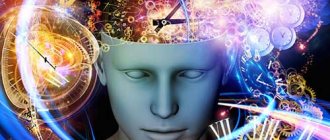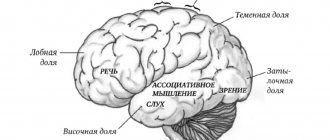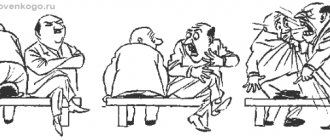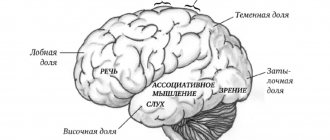Is human consciousness in psychology? Consciousness and the brain in brief! Properties of personality consciousness! Self-awareness, local focus, thought process, reflection, alter consciousness.
Hello, smart, energetic, curious readers !
Properties of consciousness
Consciousness is a reflection of objective reality in a person’s head. Each of us thinks in images that are born in the mind.
The higher the level of consciousness, the more a person is able to analyze his own actions and actions.
Consciousness allows a person to resort to deep reflection, think analytically and synthetically. A person with developed consciousness is always a person with high intelligence. The ability to analyze a situation and make responsible decisions characterizes a strong personality who knows how to admit even his own defeats.
The properties of consciousness are its significant characteristics that manifest themselves in the process of reflecting objects of the material world. Let's consider how these properties are expressed.
Basic Concepts
Consciousness is the highest function of the human brain.
It allows you to reflect the surrounding reality, interpret all current phenomena and events, plan upcoming actions and anticipate their results.
Consciousness helps you control your behavior and regulate your activities.
Its main components are: attention, memory, will, emotions and feelings.
Attention , the ability to perceive the environment and concentrate on individual objects. Attention helps a person in cognitive activity.
Memory is the ability to record learned images and reproduce them if necessary in the future.
The will directs all the actions and actions of the individual. It is a motivating force that forces you to act purposefully.
Emotions and feelings, the highest stages of development of consciousness, thanks to which it becomes possible to build interpersonal relationships and manifest internal sensations.
A special phenomenon from a psychological point of view is the ability to turn off consciousness .
Once the necessary skills and abilities are learned, they can be carried out automatically.
In this case, control over one’s behavior is no longer needed , since the body itself performs the usual actions that were practiced during the acquisition of the skill.
Thus, an experienced pianist does not think about the movements of his hands while playing, and an experienced driver does not analyze the manipulations he performs while driving.
Self-awareness is the highest level of consciousness, which reflects a person’s perception of himself as an individual. It forms ideas about one’s body, character, relationships with people, place in society, achievements, etc.
There are three main levels of self-awareness:
- First . Ideas about the body and its place in the surrounding space. At this level, there is an understanding that our body is a separate independent phenomenon, which to a certain extent is included in the existing order of things.
- Second . The attitude of oneself to a certain social group, community, social institution. At this level, the individual perceives himself through the prism of his social life.
- Third . The most complex and important level, which allows you to identify your own “I”. A person perceives himself as a full-fledged person with a set of qualities, emotions, feelings, and abilities. He fully understands his mental, emotional and intellectual needs and abilities. He is responsible for his own actions, desires and for his future.
Basic properties of personality consciousness
Activity
One of the main properties of consciousness can be considered activity. Every action that a person performs has a motive and purpose. No one acts thoughtlessly, obeying only a chaotic combination of circumstances. If the goal is desired, then the person is often ready to make even incredible efforts to achieve it. Consciousness controls human behavior and tries to calculate everything in such a way that it is most beneficial to the person himself. Our ability to predict a situation and see our own prospects is a merit of consciousness. Such a property as activity allows consciousness to remain in a working state constantly. Under what circumstances is a person ready to take active steps? In the case when he understands the need for the actions taken.
Dynamism
By dynamism we understand such an orientation towards an object or phenomenon of the surrounding reality, in which consciousness reveals the ability for continuous development. The property of dynamism is that a person’s attention is always changing. We are able to concentrate for the most part only on what is truly meaningful and interesting to us. Turning to some object evokes various emotions; we connect our feelings to what we hear and see around us, what we observe. This property of consciousness as dynamism is always aimed at immersing in the essence of the phenomenon or object in question.
Constant reflection
It must be said that the ability to analyze one’s own actions and actions is an integral and significant characteristic of consciousness. A property called “reflection” helps at the right moment to turn to the source of your “I”, your inner essence and talk with it as frankly as possible. In such internal dialogues, a person often discovers that he lived and acted incorrectly, and was inattentive to his loved ones. Constant reflection is a property of consciousness that allows for effective self-observation at different periods of life. A person almost always compares his present self with the way he was before. Such a property of consciousness as reflection makes it easy to do this. Consciousness itself is capable of expanding and expanding a person’s understanding of the world.
Values and motives
Another property of consciousness is its focus on internal sources of significance. We are talking about values for the sake of which specific actions are taken. Human consciousness is of a motivational and value-based nature. A person sometimes has to make incredible efforts on himself in order to be able to negotiate with his inner conscience. Values and motives set in motion his mental activity.
Thus, the properties of consciousness always reflect the essence of a particular personality, its internal nature and capabilities. Each person is completely individual and each has their own preferences.
What philosophers say
Philosophers believed that consciousness does not exist in isolation from reality. It is the relationship of oneself with reality.
We see the world around us and feel, perceive, think, and fantasize something in connection with it.
Different directions of philosophy interpreted this concept in their own way:
- dualism tends to divide man into consciousness and matter, where the first is spirit, the second is body. Consciousness is eternal, since it continues to live even after the physical death of the body;
- according to idealism , consciousness comes first, then the surrounding world. Matter does not exist if it is unconscious;
- materialists wrote that only highly organized matter, which is capable of creation, has consciousness (I understand that we are talking about a person).
Consciousness, its properties, characteristics
The psyche as a reflection of reality in the human brain is characterized by different levels.
The highest level of the psyche characteristic of a person forms consciousness.
Consciousness is the highest, integrating form of the psyche, the result of the socio-historical conditions for the formation of a person in work, with constant communication (using language) with other people.
Its first characteristic. Human consciousness includes a body of knowledge about the world around us. The structure of consciousness thus includes the most important cognitive processes: sensations and perceptions, memory, imagination and thinking.
With the help of sensations and perceptions, with the direct reflection of stimuli affecting the brain, a sensory picture of the world as it appears to a person at the moment is formed in the mind. Memory allows you to renew images of the past in the mind, imagination allows you to build figurative models of what is an object of needs, but is absent at the present time. Thinking ensures problem solving through the use of generalized knowledge.
The second characteristic of consciousness is the clear distinction enshrined in it between subject and object, i.e., that which belongs to a person’s “I” and his “not-I.” Man, who for the first time in the history of the organic world stood out from it and contrasted himself with his surroundings, continues to retain this opposition and difference in his consciousness. A person makes a conscious self-assessment of his actions and himself as a whole.
The third characteristic of consciousness is ensuring goal-setting human activity.
The functions of consciousness include the formation of goals for an activity, while its motives are formed and weighed, volitional decisions are made, the progress of actions is taken into account and the necessary adjustments are made to it, etc.
The fourth characteristic of consciousness is the inclusion of a certain attitude in its composition. The world of feelings inevitably enters a person’s consciousness, where complex objective and, above all, social relations in which a person is included are reflected. Emotional assessments of interpersonal relationships are represented in the human mind.
Basic functions of human consciousness
Reflective. Consciousness organizes cognitive processes (perception, representation, thinking), and also organizes memory.
Estimated. Consciousness takes part in the formation of some emotions and most feelings.
A person evaluates most events and himself at the level of consciousness.
Creative. Creativity is impossible without consciousness. Many voluntary types of imagination are organized at a conscious level: invention, artistic creativity.
Reflective. A type of consciousness is self-awareness - the process by which a person analyzes his thoughts and actions, observes himself, evaluates himself, etc.
Transformative. A person consciously defines most of his goals and outlines the path to achieving them.
Time-forming. Consciousness is responsible for the formation of a holistic temporal picture of the world, in which there is a memory of the past, awareness of the present and an idea of the future. This is how human consciousness differs from the psyche of animals.
Properties of consciousness:
Activity - Consciousness is associated with activity, with an active influence on the world around us.
Selective nature - Consciousness is not directed at the whole world as a whole, but only at certain of its objects (most often associated with some unrealized needs)
Generalization and abstraction - Consciousness does not operate with real objects and phenomena of the surrounding world, but with generalized and abstract concepts, devoid of some of the attributes of specific objects of reality.
Integrity - The consciousness of a mentally healthy person, as a rule, has integrity.
- 1. Consciousness and its properties. Types of consciousness
- 2. Self-awareness. Structure of consciousness. "I-concept"
- 3. The relationship between consciousness and the unconscious
Lecture 4. Consciousness
1. Consciousness and its properties. Types of consciousness
As a result of evolution, the nervous system and, first of all, the brain have reached a level of development that allows a person to engage in work. Under the influence of labor of a collective nature, a person began to develop mental processes that led to the emergence of consciousness - the highest level of mental development inherent only to man. Thus, the emergence of consciousness in humans has both biological and cultural-social conditionality, i.e., the emergence of consciousness outside of society is impossible. The main conditions for the emergence and development of consciousness are the appropriate level of biological development, the presence of a social environment and collective work.
Consciousness
– the highest level of mental reflection and regulation, inherent only to man as a socio-historical being. From a practical point of view, consciousness can be considered as a continuously changing set of sensory and mental images that directly appear before the subject in his inner world and anticipate his practical activity. Consciousness is studied by many sciences - philosophy, anthropology, neurophysiology, sociology, psychology, physiology, etc. All religions pay close attention to consciousness.
From a psychological point of view, we can talk about several established properties of consciousness:
1) the consciousness of an individual is characterized by activity, which is determined primarily by the specific internal state of the subject at the moment of action, as well as by the presence of a goal and sustainable activity to achieve it;
2 consciousness is characterized by intentionality[25], i.e., direction towards some object. Consciousness is always consciousness of something;
3) the ability of human consciousness for reflection[26], introspection, i.e. the possibility of awareness of consciousness itself;
4) consciousness has a motivational and value character. It is always motivated, pursuing some goals, which is determined by the needs of the body and personality.
One of the functions of consciousness is the formation of goals of activity, the preliminary mental construction of actions and the anticipation of their results, which ensures reasonable regulation of human behavior and activity. Consciousness developed in humans only in social contacts. In phylogenesis, human consciousness developed and became possible only under conditions of active influence on nature, in conditions of labor activity. In addition, both in phylogenesis and ontogenesis, speech becomes the subjective carrier of human consciousness, which first acts as a means of communication, and then becomes a means of thinking.
In psychology, there are several types of human consciousness:
• everyday
– is formed first among other types of consciousness, arises during interaction with things, is fixed in language in the form of the first concepts;
• design
– covers a range of tasks related to the design and implementation of specific business goals;
• scientific
– relies on scientific concepts, concepts, models, explores not the individual properties of objects, but their relationships;
• aesthetic
– associated with the process of emotional perception of the surrounding world;
• ethical
– determines a person’s moral attitudes (from extreme integrity to immorality). Unlike other types of consciousness, the degree of development of a person’s ethical (moral) consciousness is difficult to assess by himself.
Along with the development of civilization, human consciousness continues to develop, and at the present historical moment this development is accelerating, which is caused by the accelerated pace of scientific, technical and cultural progress.
2. Self-awareness. Structure of consciousness. "I-concept"
The necessary and first stage in the formation of consciousness is self-awareness, i.e., awareness of oneself, one’s “self.” Self-awareness manifests itself as self-knowledge, self-esteem, self-control and self-acceptance.
Self-knowledge
– this is a person’s focus on knowing his physical (bodily), mental, spiritual capabilities and qualities, his place among other people. Self-knowledge is carried out through analysis of the results of one’s own activities, one’s behavior and relationships with other people, through awareness of the attitude of other people towards oneself and through self-observation of one’s states, experiences, thoughts, and actions.
Self-knowledge is the basis for self-esteem,
which includes knowledge of the scale of values by which a person can evaluate himself. Self-esteem can be adequate (real) and inadequate - either overestimated or underestimated. The American psychologist W. James has a formula for human self-esteem[27]:
L.N. Tolstoy expressed the idea that a person is a fraction that strives for unity, but never reaches it. The numerator of this fraction is what a person is, and the denominator is what he thinks about himself.
Self-knowledge is the basis for constant self-control,
which manifests itself in a person’s awareness and assessment of his own actions.
The result of a person’s self-knowledge is his self-acceptance
– his development of a system of ideas about himself, or “I-image”, which determines the individual’s attitude towards himself, is the basis for building relationships with other people.
The ability to reflect determines a person’s ability to observe himself, his state, which determines the formation of his individual “I-concept”,
which is the totality of a person’s ideas about himself.
A person evaluates all information about the world around him on the basis of ideas about himself and forms behavior based on his system of values, ideals and motivational attitudes. “self-concept”
is strictly individual, since different people have different assessments of ongoing events, the same objects of the real world, and the assessments of some people are quite objective, i.e., they correspond to reality, while the assessments of others, on the contrary, are extremely subjective .
In psychology, there are two forms of “I-concept” - real and ideal. The main thing in the real one is the person’s idea of himself, which corresponds to reality, and in the ideal, the person’s idea of himself in accordance with his desires, i.e., the way a person wants to be. For most people, the real and ideal self-concepts are different. These discrepancies can lead to both positive and negative consequences: on the one hand, it can lead to intrapersonal conflict, and on the other hand, it can become a source of personal self-improvement.
3. The relationship between consciousness and the unconscious
All mental phenomena can be divided into two groups. The first are realized by the person himself. The manifestation of the latter is not reflected in the human consciousness - they are called unconscious processes,
or
unconscious.
The unconscious
is a set of mental processes, acts, states caused by such influences, the influence of which a person is not aware of on his behavior.
There is no self-control or self-esteem here. Elements of the unconscious are represented to one degree or another in many mental processes, for example, an unconscious sense of balance, unconscious images of perception associated with the recognition of what was previously seen. The unconscious in a person’s personality is those aspects of personality that a person is not aware of in himself, but which are inherent to him and manifest themselves involuntarily.
A.G. Asmolov proposed [28] to combine various manifestations of the unconscious in human behavior into the following groups:
¦ supra-individual supraconscious phenomena
- these are patterns of behavior that are typical for a given group (community), acquired by the subject, the influence of which is not realized by the person himself. These patterns, learned through imitation, determine the socially typical characteristics of human behavior;
¦ unconscious motives of behavior
– being repressed from the consciousness of the individual due to a conflict with the social demands of society, hidden drives form hidden complexes that affect the individual and manifest themselves in indirect symbolic forms (dreams, slips of the tongue, slips of the tongue, etc.). Such unconscious motives can be identified by S. Freud's method of psychoanalysis;
¦ unconscious reserves of the senses
– influence on the behavior of such stimuli that a person cannot give himself an account of; such phenomena were described by I.M. Sechenov as the “sixth sense”;
¦ unconscious regulators of ways of performing activities
(operational attitudes and stereotypes) - arise in the process of solving various problems (perceptual, mnemonic, motor, mental) and are predetermined by past experience of behavior in similar situations.
The psyche in general, consciousness and the unconscious in particular ensure a person’s fitness and adaptation to the outside world. Consciousness controls the most complex forms of behavior that require constant attention and conscious control. But many behavioral acts are performed by a person on an unconscious level. Consciousness and the unconscious are qualitatively different levels of orientation in reality, each of which makes its own contribution to the regulation of the subject’s activity.
Table of contents
Basic properties of consciousness
Within this property, internal conflicts of values or interests are possible.
Constancy - Relative stability, immutability and continuity of consciousness, determined by memory.
The constancy of consciousness is determined by the properties of the individual.
Dynamism - Its changeability and ability for continuous development, determined by short-term and rapidly changing mental processes that can be fixed in the state and in new personality traits.
Distortion - Consciousness always reflects reality in a distorted form (some of the information is lost, and the other part is distorted by individual characteristics of perception and personal attitudes)
Individual character - The consciousness of each person is different from the consciousness of other people.
This is due to a number of factors: genetic differences, upbringing conditions, life experience, social environment, etc.
Ability to reflect - Consciousness has the ability to introspect and self-evaluate, and can also imagine how other people evaluate it.
Human psyche as a system, its structure, components and elements
2.1. Psyche and body. Brain and psyche
Psyche
(from ancient Greek, spiritual) - the ability of a subject to actively reflect objective reality, which arose as a result of the interaction of highly organized living beings with the outside world.
Basic functions of the psyche:
- reflection of the surrounding world;
- ensuring the integrity of the body;
- regulation of behavior.
The integrative function of the psyche is to ensure the body’s adaptation to environmental conditions.
The psyche is the result of the complex activity of the nervous system, the structural and functional unit of which is the neuron (nerve cell).
Neuron
(
from ancient Greek fiber
)
is an electrically excitable cell that processes and transmits information through electrical and chemical signals.
Rice.
2.1. Neuron structure
Each neuron consists of a cell body (or soma
), which contains the cell nucleus.
From the cell body of a neuron grow dendrites
(short branches that receive nerve impulses going to the neuron) and
an axon
(a long thin tubular process that transmits nerve impulses from the neuron).
Neurons form chemical or functional connections with other neurons, making up a neural network
(eng. biological neural network);
points of conjugation (contact) of neurons in the network are called synapses
.
Stimulation of excitatory synapses causes a nerve impulse
, running along the axon.
Signals travel from one neuron to another through a complex electrochemical reaction. The transmission of signals from the sense organs to the brain and spinal cord is carried out by sensory neurons
, and from the brain and spinal cord to the muscles and glands by
motor neurons
.
Nerve
- a sheathed bundle of axons in the peripheral nervous system, which is the path for electrochemical nerve impulses transmitted along each of the axons to the peripheral organs.
Nervous system
humans and mammals consists of
a central nervous system
(
brain
and
spinal cord
) and
a peripheral nervous system
(cranial and spinal nerves, nerve plexuses).
Peripheral nervous system
consists of
the somatic nervous system
and
from the sensory organs, muscles, skin, and
the autonomic
nervous
system
, which regulates the activity of internal organs, glands, blood and lymph vessels.
Brain
- the center of the nervous system, the physiological functions of which are to centrally control all other organs of the body. The brain consists of the central brainstem, limbic system and cerebrum.
Rice.
2.2. Main parts of the brain (cross section)
To the central trunk
relate:
- medulla oblongata
, whose functions include protective reflexes (coughing, sneezing, swallowing, vomiting), vital reflexes (breathing), regulation of vascular tone; - cerebellum
, whose functions are coordination of movements, regulation of balance and muscle tone, muscle memory; - thalamus
, responsible for the redistribution of incoming sensory information (with the exception of smell) to the cerebral cortex; - hypothalamus
, which regulates all body functions (except heart rate, blood pressure and spontaneous respiratory movements), as well as human emotions and behavior.
Reticular formation
(from Latin rete - network) - a structure consisting of more than 100 small neural networks of the brain stem and upper spinal cord that filters incoming sensory information and transmits it to the limbic system and cerebral cortex.
The limbic system located within the thalamus
participates in the regulation of the functions of smell and internal organs, controls instinctive behavioral reactions, emotions, memory, and plays an important role in learning.
Big brain
(cerebrum) consists of two
cerebral hemispheres
, covered with a convoluted
cortex
, which plays a key role in the implementation of higher mental functions - memory, attention, perception, thinking, language and consciousness.
Left hemisphere
The brain specializes in expressive and impressive speech, reading, writing, verbal memory, verbal and abstract thinking, is focused on forecasting,
the right
is responsible for visual-spatial orientation, non-verbal memory, and specific figurative thinking.
Vegetative
(
autonomic
)
nervous system
consists of two systems:
- sympathetic
, which mobilizes the body’s nervous system in stressful situations, increasing metabolism and increasing tissue excitability; - parasympathetic
, whose functions are associated with actions that do not require an immediate reaction (salivation, lacrimation, urination, digestion, defecation).
The autonomic nervous system plays an important role in emotional reactions because its fibers mediate the functioning of smooth muscles and glands. Endocrine glands
(
endocrine glands
) synthesize and release hormones into the bloodstream that affect emotional state and motivation.
The human psyche is influenced by heredity
.
The molecular unit of heredity of a living organism is genes
- sections of DNA and RNA that store information about the creation and maintenance of body cells and transmit genetic characteristics to offspring.
Properties of consciousness
The term “consciousness” (co-knowledge) is currently a generalization that suggests itself based on the development of philosophy, anthropology, psychology and other areas of knowledge in the humanities and natural sciences, can be understood as the highest level of mental reflection and joint action.
Some naive anthropocentrists believe that such a level of development is possible only among representatives of human society. Meanwhile, scientists more familiar with the natural sciences would not say so.
In its most general form, from a systemic-pragmatic point of view, consciousness is a set of permanently changing sensations, sensory and mental images that appear before the inner gaze of a conscious subject and predetermine his practical and mental activity.
The properties of consciousness are studied in some branches of psychology, as well as in other areas of knowledge.
Conscious and unconscious actions
Consciousness does not exclude unconscious activity. If at first we analyze our actions, evaluate them, reflect on the situation or a question that is new to us. All this is recognized without human intervention in psychological activity. However, the process of fulfilling and achieving the set goal is automated.
Unconscious actions include walking, singing, speaking, reading, counting, and writing. To achieve automation, a person actively manages these processes and works hard on them. Moreover, such unconscious repetition of habitual actions can in an instant go from automated to controlled and controlled. In an unconscious state, a person is not able to objectively assess the situation, he does not control it and does not own this problem, he needs help, his behavior is disrupted and there is no ability to keep track of time.
A clear manifestation of unconscious activity is sleep. During this complex process, countless reactions occur in the brain. GNI is inhibited, and thanks to dreams, psychological exhaustion is prevented.
Dreams are one of the forms of consciousness, which is characterized by the presence of ideas. One of the scientists emphasized that dreams are an amazing combination of past experiences. What we see in a dream has already happened in life. Some absurd pictures that may appear before our eyes are based on experiences that have already occurred, which enter into reactions and various connections in a certain part of the brain.
When we wake up, we move from an unconscious state to a conscious state. Therefore, life is a unity and harmonious combination of subconscious life and conscious life.
Consciousness is especially necessary in such situations:
In solving complex and conflict situations. Make a decision if necessary. At the moment of psychological or mental threat. As necessary to overcome psychological or mental resistance.
Marketers especially often take advantage of a person's ability to act unconsciously. These people purposefully use a person’s tendency not to catch some information, but immediately put it into the subconscious. As a result, when a person sees similar information again, it seems familiar to him and, accordingly, necessary. So, without realizing it at all, we purchase goods that we do not need at all.
Scientists have realized that it is possible to easily control a person’s psyche by providing him with information at a certain moment. So this knowledge bypasses consciousness and is immediately deposited in the subconscious. This theory is called the 25th frame.
The ability of the brain to quickly perceive new information without the participation of consciousness and remember it well is used not only for the selfish purposes of marketers. There are a number of methods for learning a foreign language. One of the most effective is to use the 25th frame. The training lasts 45 minutes, which are divided into three parts. During the first, you are offered to view pictures with written foreign words, which change 25 frames per second.
Then, for the next 15 minutes, review the same words, but listen to the pronunciation. This lesson proceeds at a normal pace. The last 15 minutes are practice and you need to make an effort to get the right words out of your subconscious. Thanks to this technique, a person is able to memorize 7,000 new foreign words in just an hour, and these words remain in memory, although you may not use the language you are learning. Compared to the traditional way of teaching and learning a foreign language, you will have to put in a year and a half of effort.
Properties of consciousness in psychology
There are several basic psychological properties of human consciousness:
- The consciousness of a person (as an aware subject) is necessarily distinguished by activity, most of all conditioned by the specific specifics of the internal state of the subject at the time of action. In most cases, we can talk about the subject having a specific goal and consistent vectors of activity to achieve the goal.
- The consciousness of the subject is characterized by intentionality, that is, a focus on something (not necessarily an object of the material world, not necessarily a specific one). Consciousness is always awareness (or awareness, and at the moment of communication with another subject or group, even co-awareness) of some fact or thought.
- Consciousness is characterized by constant reflection, that is, the subject undergoes a process of continuous introspection. The subject may be aware of the very presence of consciousness and recognition.
- Consciousness is mainly of a motivational and value-based nature (at least among Europeans). Of course, at the present moment in the development of knowledge about man, it would be naive, rude and flat; it would be in vain to think that consciousness is always motivated. This is a mossy thought from the middle of the last century. However, it can definitely be argued that a real subject in our world always strives for a goal (even if the goal is the absence of a goal), he is forced to this by attachment to a completely material living organism.
Other important properties of consciousness include: integrity, abstraction, generality, selectivity, dynamism, distortion, uniqueness and individuality.
In general, it should be understood that although consciousness arises in our world only in real living thinking subjects, it is classified as the sphere of the ideal, since images, sensations and meanings cannot be considered as material objects.
Consciousness vs subconsciousness
The human psyche contains consciousness and subconsciousness. To better understand this information, scientific literature often shows an image of an iceberg, most of which is hidden under water.
Its tip, sticking out above the surface, is consciousness. What is hidden under water and invisible is the subconscious. The surface of the water is the boundary between consciousness and subconsciousness, which are interconnected but never mixed.
Something can, of course, be fished out from the lower layer (psychologists use various techniques for this), but it is impossible to pull out and understand literally everything. A lifetime is not enough.
We have found out what consciousness is. This is what exists at a given moment in time, and what we can control. What is the subconscious? Freudians contrast both of these concepts as directly opposite.
By the way, it was Freud, the creator of psychoanalysis, who actively spoke about unconscious processes, and his psychotherapy was to penetrate into the deep layers of the human psyche and discover unconscious conflicts there that become the cause of neuroses.
The subconscious mind stores all the information about what an individual has ever seen, heard, felt, sensed, said and thought about. You can call the subconscious a warehouse or repository of mental experience.
Imagine that you are walking through a park: there are many flowers, trees, people with children, strollers, dogs, benches, etc. around. And so you look at passers-by, not paying attention to the vegetation.
But since the latter still caught your eye (you just didn’t realize it), the information about green plants will be imprinted and go straight to the subconscious. That same night you will see trees in a dream and you will be surprised why and why did you have such a dream?
And dreams are “hello from there,” from the unconscious part. They are often strange and illogical: this happens because in the world of dreams (what dreams are) no laws (scientific, political, personal, etc.) work.
Also, the subconscious mind stores negative experiences, elements of reality that a person cannot realize painlessly for himself, which have a destructive effect on the human psyche (shocking events, deaths, rapes, etc.).
The main function of the subconscious is to maintain mental health. If we were aware of literally everything, we would go crazy long ago.
For this purpose, there is a censor in the psyche, standing on the border between consciousness and subconsciousness. Conditioned by multiple indicators, it is he who decides what will pass into the zone of awareness and what will remain hidden.
Author of the article: Liliya Sergeevna Kovalenko (psychologist)
Good luck to you! See you soon on the blog pages KtoNaNovenkogo.ru
Comments and reviews (6)
«>
the soul is consciousness
«>
after: It has long been proven that only man is endowed with consciousness: it is his main distinguishing feature in comparison with other living beings.
You don't have to read it. Author, if you are watching Chernigovskaya’s video and are interested in issues of consciousness, then how can you write this?
«>
Good article, thanks! A small request to indicate the authors of the articles. Or are they on Her Majesty's secret service?!










